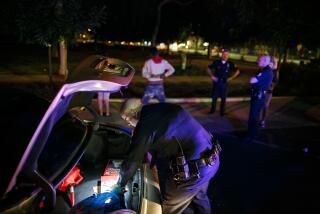ASIA : Bringing Order to Chaos: China Traffic Takes New Direction
- Share via
JINAN, China — Until a few weeks ago, the scene in the middle of a busy intersection in Chinese cities often went like this: A surly traffic cop in a slovenly uniform stood beside his center island pedestal exacting a fine from a penitent motorist, who pleaded desperately for a break. Scores of bicyclists, necks craned to eavesdrop on the law enforcement drama, clogged the turn lanes. Meanwhile, traffic backed up for blocks, even miles.
But that was before the national Department of Public Security launched its “Learn From the Traffic Policemen of Jinan” campaign last month to try to build up the sunken image of China’s law officers in olive drab.
Now, in the national capital, Beijing, in the northern Manchuria city of Harbin, in the bustling Sichuan provincial seat Chengdu and in dozens of other cities, the scene is suddenly much different: Atop the traffic pedestal is a transformed man in a crisp uniform, shoulders squared, who spins smartly on the balls of his feet as he executes the 11 precise traffic directional signals perfected by the Jinan masters.
Gone is the arrogant expression. Gone are the rubbernecking bicyclists. Gone--well, not completely--are the endless traffic snarls that have accompanied China into the automotive age.
Here in the Shandong province capital that is the role model for this overnight transformation, the street officers have taken the phenomenon to another level. Every major intersection is equipped with a citizen service center where police dispense bicycle pumps for deflated two-wheelers, handy maps for lost motorists and even cold remedies for ailing pedestrians.
A chalkboard notes the day’s weather facts. A complaint book hangs from a chain so citizens can note their opinions, mostly glowing. And instead of fines, minor traffic violators are handed a triangular yellow flag and instructed to assist in the smooth direction of traffic for 15 minutes or more, depending on the severity of the offense.
Needless to say, this has greatly enhanced police public relations here. “We used to arrange the people to aid the traffic,” explained model officer Wang Lei, 27, who heads the Civilized Traffic Police Group at one of Jinan’s busiest intersections. “Now we arrange the traffic to aid the people.”
The “Learn From the Traffic Policemen of Jinan” campaign has been personally endorsed by Jiang Zemin, China’s president and Communist Party leader. The People’s Daily and other newspapers have all published long front-page features mostly describing the physical and personal sacrifices made by police as they learn the stiff, robotic traffic direction signals and new citizen-friendly attitude.
The Beijing Ribao newspaper reported that one young officer was so exhausted by the rigorous training that he lost his sex drive. Another newspaper counted a newly trained officer’s moves as he spun on his traffic pedestal 800 times in an hour and performed 1,200 signals.
This street trend started 18 months ago, when Li Changshui, director of the traffic detachment in Jinan, wanted to do something to improve the image and the morale of his officers.
As economic development has made automobiles accessible to more Chinese, most cities have traffic problems caused by the sudden increase in motor vehicles on streets that often date to the rickshaw era. The number of cars in China has increased from 1.7 million in 1980 to 9.4 million in 1994.
But because bicycles and pedestrians clog crosswalks in China’s overcrowded cities, local governments have been unable to completely automate the traffic direction system. Police--stationed in the noisy, polluted center of congested streets--are still needed.
Li’s idea was to choreograph the routines of his 1,000 officers with an adapted form of formal traffic direction borrowed from the military. In the summer of 1994, he sent 37 of his officers to Beijing to study the seldom-used direction signals in the Department of Public Security’s archives.
When officers began to use them in Jinan on April 26, they were an instant hit. The central government spotted the Jinan approach as something worth copying on a national scale.
“Now the policemen in our intersections are tourist attractions for the city,” Li said proudly.
More to Read
Sign up for Essential California
The most important California stories and recommendations in your inbox every morning.
You may occasionally receive promotional content from the Los Angeles Times.













